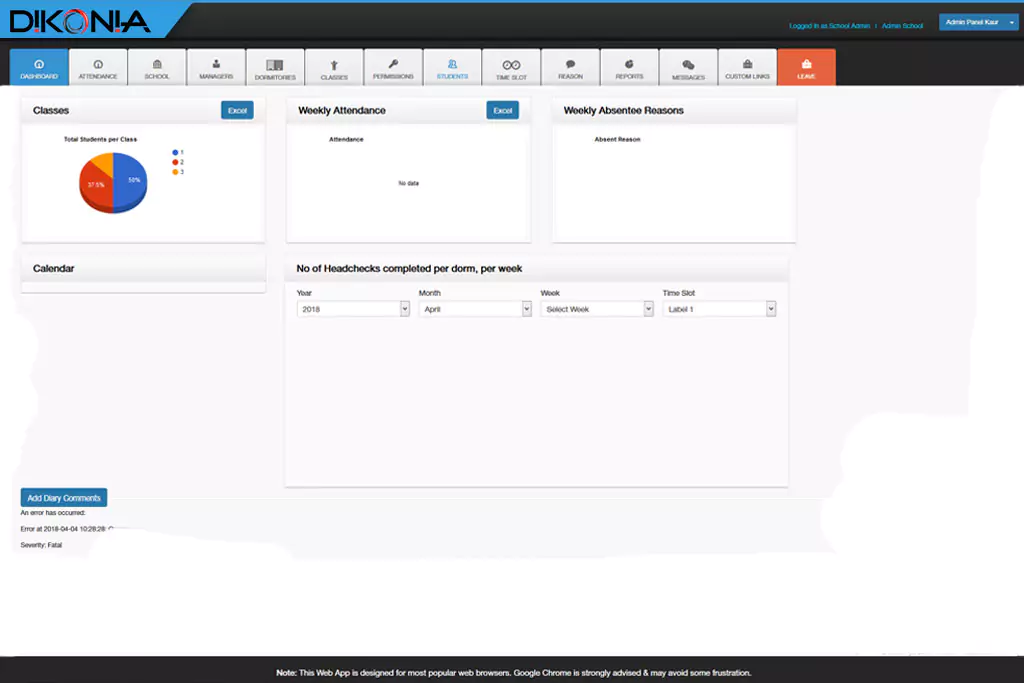In addition to connecting us beyond physical boundaries, internet has also revolutionized the attainenance of education in the 21st century.
There’s hardly any modern educational institution today that doesn’t make use of a comprehensive Learning Management System (LMS) for organizing their course and student data.
In fact, “67% of institutions now offer portable learning in some shape” says eLearning Industry. Such a system helps in managing the large amount of information associated with every course offered by the institution and makes learning highly convenient for the students with the help of online tutorials and MOOCs.
Here at Dikonia, we recently developed a custom LMS application for one of our clients and we have important insights to share about the experience.
Custom Learning Management System Development
A custom LMS as described earlier, acts as a platform for the teachers, the administration and the students to gain online access to the educational courses organized in an interactive format.
This helps students to study online and while teachers and administrators can upload course material using an integrated backend.
Our project inculcated all these features in a University Level application customized to suit the client requirements.
Technology
While there were a number of competitors for the development of the application, we chose what we felt resolved our use cases in the most effective manner. Here is a brief about them.
PHP Framework: CakePHP 3
CSS Framework: Twitter Bootstrap
Base Code: HTML5 and CSS3
Integrations: Modernizr JS
Features: eLearning, live group chats, course backend, student logins and Course Management.
As you can see that CakePHP helped us in rapidly developing the application, utilizing its innovative development environment. The CSS was aided by the use of Twitter Bootstrap which found the perfect fit for the application’s styling requirements. Further with the help of Modernizr, we were able to achieve cross platform stability.
Features
Hierarchical Learning
The educational courses offered by the application are divided into a well defined hierarchy that simplifies the progress for each course.
Each course has its own Units that are further divided into Topics. These units and topics formulate the complete structure of the course that contains Quizzes and Tests that the user must pass in order to proceed further with the course.
Peer Discussions and Student Evaluation
The application makes the process of student evaluation highly interactive with the help of online tests and quizzes. These quizzes can be designed in a number of formats such as;
Text Based Quizzes
Single Choice Quizzes
Multiple Choice Questions
These quizzes form a part of the continuous student evaluation and provides the students a great way to measure their progress with each Unit.
Further, students can obtain responses from teachers on assignments for better clarification of doubts. This takes away the robotic factor from the application.
Course Management
Then comes a unique system for course management. As it is an e-learning platform, users have access to an Interactive Courses that combine video lectures, quizzes and text based information in an easy-to-grasp way.

The application also provides freedom to develop and upload these courses from the teacher’s side in an integrated way. Teachers don’t have to follow a strict format to design the courses and one can easily curate a particular course for maximum design efficiency.
Backend For Teachers and Administrators
The application can’t possibly function without a fully comprehensive backend or an Admin Panel which is the greatest challenge for any kind of dynamic project.
For this application, we went in for a fully custom developed backend that was divided into different user roles for Teachers and Administrators.

The Admins can use the application backend for gaining insights into the financial analytics, student information and to look over other tasks of the whole system.
On the other hand, teachers can use it to upload assignments, design courses and quizzes and interact with the students with a group chat facility. While there are many overlapping features for Teachers and Admins, the latter can exercise greater control over the system as per requirement.
Website Blogs and Community Interaction
Blogging is an essential part of every popular user platform because it provides a mode for rich community interaction.
Therefore, we went ahead and included a built-in blogging section where the Admin can publish useful information for the general audience who are interested in the application. This serves the important purpose of content marketing as well as interacting with the community on a passive basis.

The blog is enabled with all the modern blogging features such as integrated analytics and support for adding various multimedia such as videos, pictures and text to the blog.
Further, the blog can be organized with the help of tags and titles.
Our Experience with the Application
The custom LMS is our portfolio-first project and we initiated it with no experience at hand. Although we have completed tons of projects that involved the use of logical representation of data and comprehensive user experience design, but a project of this complexity was a challenge.
We overcame the challenge with constant client communication and with a closely knit approach for its development. The prototype engineering model helped us in moving the project forward with client approval at every module that we developed. On a whole, it was a remarkable experience!
Got an idea on you? Discuss it with us today and see your new project turn into a reality with Dikonia.

